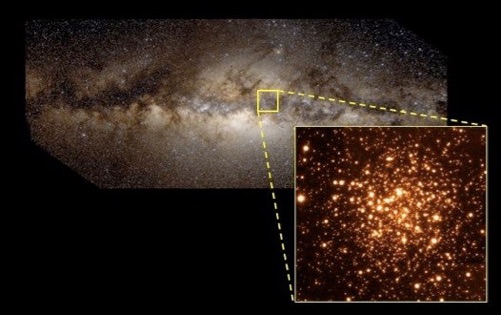Adaptive-optics observations
Adaptive optics is a technique that allows astronomers to overcome the blurring that the Earth`s turbulent atmosphere inflicts on astronomical images obtained from ground-based telescopes.
The exceptional ground-based images of the central regions of Terzan 5 were obtained with two technical jewels able to superbly compensate for the degradation effects of the Earth atmosphere, and producing very sharp images at near-infrared wavelengths, with spatial resolutions comparable to or better than those achieved by the Hubble Space Telescope at optical wavelengths:
-
★MAD (Multi-conjugate Adaptive Optics Demonstrator) was a prototype of the next-generation multi-conjugate adaptive optics instruments temporarily installed at the ESO-VLT in 2008;
-
★NIRC2 (the Near-Infrared Camera, second generation) works in combination with the Keck II telescope’s adaptive optics system. NIRC2 is probably best known for helping to provide definitive proof of a central massive black hole at the center of our galaxy. Astronomers also use NIRC2 to map surface features of solar system bodies, detect planets orbiting other stars, and study detailed morphology of distant galaxies.
Additional material
The Galactic Bulge
The Milky Way is one of the billions spiral galaxies wondering through the Universe. Its main components are (1) a disk of (mainly) young and metal-rich stars and gas clouds, following a spiral pattern; (2) a dense centrale Bulge of old and metal-rich stars, and (3) a huge almost pherical halo populated by old and metal-poor globular clusters.
The galactic Bulge is the most inaccessible region of our Galaxy, since thick clouds of dust prevent optical light from emerging. Indeed, only infrared radiation can travel across these clouds and bring us direct information on the stars populating this region. Terzan 5 is a globular cluster-like stellar system orbiting the Bulge at a distance of 19.000 light years from the Earth and less than 4000 light years from the Galaxy centre, where a huge black hole (of a few million solar masses) sits.

Schematic representation of the Milky Way as seen edge-on.
Terzan 5
The target of the study is the star cluster Terzan 5, a stellar system that has been catalogued as a globular cluster since 1968, when it was discovered by the French astronomer Agop Terzan. The first surprise from this system came out in 2009, when two populations with significantly different metallicities have been discovered. The new observations show that in Terzan5, at odds with genuine globular clusters, stars have formed in at least two very different epochs, the earliest probably some 12 billion years ago and then again 4.5 billion years ago.

MAD image of Terzan 5 superimposed to a mosaic of images of the Galactic plane in the central Bulge region. The dark area are thick clouds of dust that prevent optical light from emerging.

